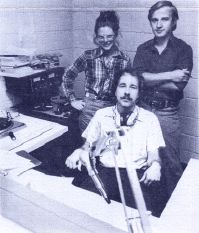Non-commercial Broadcasting
in West Virginia
 Ralph Johnson (seated), Beth Sherman, and
Ralph Johnson (seated), Beth Sherman, and
Rich Eiswerth of West Virginia Public Radio in 1977.
This timeline does not include very low power AM stations, called
"carrier-current stations," which have existed on some college
campuses, usually designed to cover the dorrmitories. I have very
little information on these stations. The 1975 Broadcasting
Yearbook lists WMHC at Morris Harvey College, WGSC at Glenville
State College, WCAB at Alderson-Broaddus College, WVBC at Bethany
College, WVWC at W. Va. Wesleyan College, WMUL at Marshall
University, and WVSC at Salem College, all of which presumably were
carrier-current stations. I know that there was a carrier current
station at Concord College in the 1970s on 690 kHz. There may have
been one at Davis and Elkins College much earlier.
Mar. 16, 1922. A license
is granted for radio station WHD, operated by the physics department
at West Virginia University. The station operated on 360 meters
with about 5 watts. [The license was deleted on Nov. 19, 1923.]
Apr. 14, 1952. The FCC
announces allocations of TV channels, with the following channels
allocated for non-commercial use in West Virginia: Charleston,
channel 43; Huntington, channel 53; Morgantown, channel 24; Wheeling,
channel 57. [In addition, channel 5, allocated to Weston, apparently
was changed to a non-commercial allocation temporarily.]
Nov. 1, 1961. WMUL(FM)
Huntington, licensed to Marshall University, begins broadcasting on
88.1 MHz with 10 watts, the first radio station in West Virginia to
receive a license designated as non-commercial. [An aircheck of the
first 15 minutes of the initial broadcast is here.]
1962. Governor Barron creates
the West Virginia Educational Broadcasting Authority by executive
order. In 1963, the state legislature formally creates the WVEBA.
Jan. 1, 1966. WVBC-FM
Bethany, licensed to Bethany College, begins broadcasting on 88.1 MHz
with 10 watts.
Sept. 1968. WVWC(FM)
Buckhannon, licensed to West Virginia Wesleyan College, begins
broadcasting on 88.9 MHz with 14,000 watts.
Feb. 25, 1969. WWVU-TV (later
WNPB-TV) Morgantown begins broadcasting on channel 24. [According to
the 1972 Broadcasting Yearbook, the start date is Feb. 23,
1969.]
July 14, 1969. WMUL-TV (later
WPBY-TV) Huntington begins broadcasting on channel 33.
Nov. 1, 1970. WSWP-TV
Grandview begins broadcasting on channel 9, the first VHF
non-commercial TV station in West Virginia.
1973. WFGH(FM) Fort Gay,
licensed to the Wayne County Board of Education, begins broadcasting
on 90.7 MHz with 7800 watts.
Mar. 30, 1973. WJGF-FM
Romney, licensed to the West Virginia School for the Deaf and Blind,
begins broadcasting at 91.5 MHz with 10 watts.
1974. WSHC(FM) Shepherdstown,
licensed to Shepherd College, begins broadcasting on 88.7 MHz with 10
watts.
May 1, 1974. WVPB(FM) Beckley
begins broadcasting on 91.7 MHz at full power. Operation of the
station was initially shared by WSWP Television and the Raleigh
County Vocational-Technical Center. WVPB became the first station of
West Virginia Public Radio.
1975. The WVEBA takes over
West Virginia Wesleyan's college station (WVWC), which becomes
WVPW(FM). West Virginia Public Radio now consists of WVPB Beckley
and WVPW.
1975. WCDE(FM) Elkins,
licensed to Davis and Elkins College, begins broadcasting on 90.3 MHz
with 10 watts.
Oct. 1975. WQAB(FM) Philippi,
licensed to Alderson-Broaddus College, begins broadcasting on 92.1
MHz with 10 watts.
July 29, 1976. WITB-FM Salem,
licensed to Salem College, begins broadcasting on 91.1 MHz with 10
watts.
Apr. 4, 1977. WPHP(FM)
Wheeling, licensed to the Ohio County Board of Education, begins
broadcasting on 91.9 MHz with 10 watts.
Sept. 5, 1977. WVWC(FM) at
West Virginia Wesleyan College in Buckhannon, having trasferred its
larger facilities to the West Virginia Educational Broadcasting
Authority, begins operation as a campus station, broadcasting on 92.1
MHz with 10 watts.
Nov. 24, 1978. Radio station
WHPW goes on the air in Huntington on 89.9 MHz with full power.
May 8, 1979. WVPN(FM)
Charleston begins broadcasting on 88.5 MHz with full power.
Operation of public radio is transferred from Channel 9 to the state
capitol complex in Charleston and the term West Virginia Public Radio
is adopted. The first fund drive is held. [The date for WVPN is
June 28, 1979, in Broadcasting Yearbook.]
May 27, 1981. WVPM(FM)
Morgantown begins broadcasting on 90.9 MHz with full power, the fifth
station of West Virginia Public Radio. [Broadcasting Yearbook
has June 1, 1981.]
Aug. 17, 1981. WVMR(AM) Frost
begins broadcasting on 1370, licensed to the Pocahontas
Communications Cooperative Corporation, the first non-commercial AM
station in West Virginia.
Oct. 7, 1981. WVNP(FM)
Wheeling begins broadcasting on 89.9 MHz with full power.
Aug. 20, 1982. WWVU-FM at
West Virginia University begins broadcasting on 91.7 MHz with 380
watts
Nov. 1982. The 446-ft.
transmission tower of WSWP-TV at Layland collapses while the antenna
is being replaced. No one is injured, but WSWP and the four West
Virginia Public Radio stations are temporarily off the air.
1983. WWVU-TV is transferred
from West Virginia University to the WVEBA.
1985. The call letters of
WHPW Huntington are changed to WVWV.
July 4, 1985. WVPG
Parkersburg goes on the air on 90.3 MHz with full power.
Nov. 1, 1985. WEYS(FM) in
Institute, licensed to the Kanawha Economic Development Corporation,
begins broadcasting on 90.9 MHz with 1900 watts.
June 29, 1986. Mountain
Stage, a two-hour live variety show produced by West Virginia
Public Radio, begins national distribution via NPR.
Feb. 11, 1987. WVEP(FM)
Martinsburg begins broadcasting on 88.9 MHz with full power, the
eighth full-power FM transmitter for West Virginia Public Radio.
Dec. 3, 1987. West Virginia
public radio begins broadcasting from its present quarters at 600
Capitol Street in Charleston.
Dec. 1992. WKJL Clarksburg,
licensed to He's Alive Inc., begins broadcasting on 88.1 with 23500
watts.
1994. Ten-watt translators
for West Virginia public radio are installed to serve Clarksburg and
Elkins.
Dec. 1, 1997. WAUA(FM)
Petersburg was scheduled to begin broadcasting on 89.5 MHz with full
power.
1998. Translators for West
Virginia Public Radio are erected in Logan, Matewan, and Union.
|